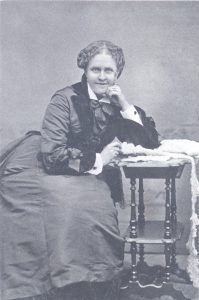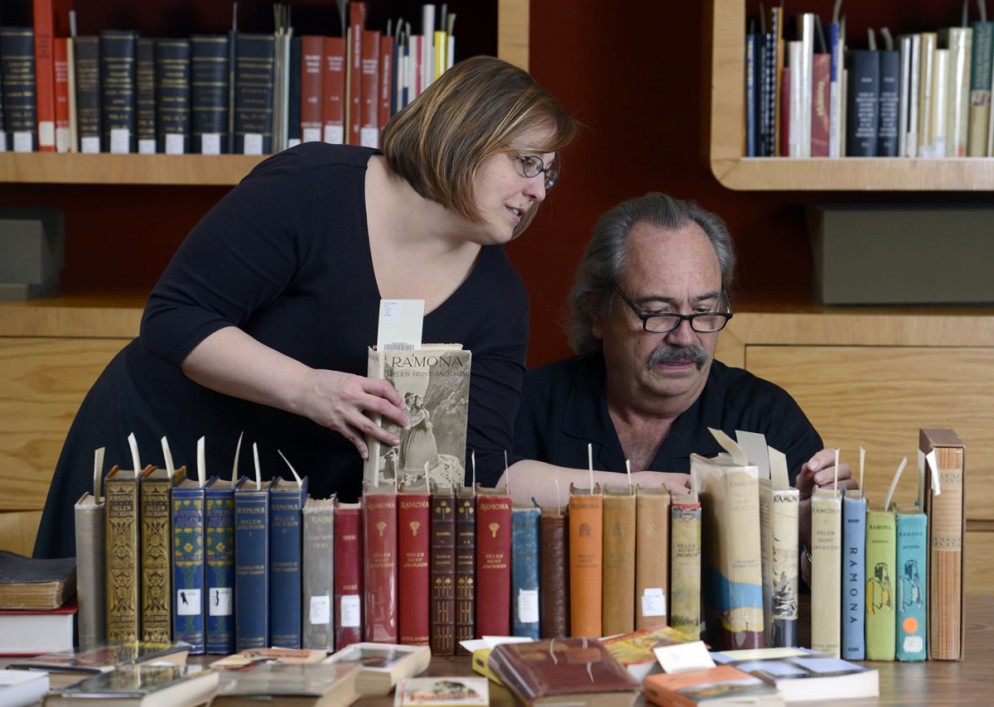Tutt Library Stores a Very Special Collection Behind Its Doors
Soon Colorado College’s Tutt Library may be known across the country, perhaps even the world, for its groundbreaking environmental capabilities. But when it comes to its basic function as a facility for study and knowledge, it’s already known across the world for a very special reason: holding the most complete collection of letters, diaries, and personal papers from author/activist Helen Hunt Jackson. Add to that “just about every edition of ‘Ramona’ that’s ever been published — and it’s been continually in print since 1884 to today,” says Special Collections Curator and Archivist Jessy Randall, and it’s understandable why researchers from across the globe make time to trek to Colorado College.
Jackson moved to Colorado Springs in 1873 for her health. Her first husband, U.S. Army Captain Edward Bissell Hunt, and their two sons had died, and, while in Colorado Springs, she met, and eventually married William S. Jackson. (Randall notes that while today she is often known as Helen Hunt Jackson, she never would have referred to herself that way: “That’s two married names. She would have been either Helen Hunt or Helen Jackson.”)
Though Jackson wrote many books, collections of poems, and essays, 1884’s “Ramona” is her main claim to fame nowadays. Set in Southern California after the Mexican-American War, the novel tells the story of a Scots-Native American orphan girl and the discrimination she faces due to her mixed-race background.
 “When Jackson was alive, and in the decades after her death, it was a hugely popular book,” Randall says. “At one point it was being advertised as ‘Everyone has read “Ramona.” ’ I can’t even think of a book today that would be like that. … I’ve asked CC students, ‘Is there a book every single person in the room
has read?’ ‘Harry Potter’ is the closest we get.”
“When Jackson was alive, and in the decades after her death, it was a hugely popular book,” Randall says. “At one point it was being advertised as ‘Everyone has read “Ramona.” ’ I can’t even think of a book today that would be like that. … I’ve asked CC students, ‘Is there a book every single person in the room
has read?’ ‘Harry Potter’ is the closest we get.”
What made it that way?
At the time of the book’s publication, it was political criticism of the mistreatment of Native Americans, but, as Randall explains, it was also just “an entertaining yarn, a great love story and all.” And Jackson was a commercial writer who, in Randall’s opinion, was also a very good self-saleswoman who knew how to do her own PR campaigning. “She talked about writing the book in a way that made it sound very enticing. She said she sat down and she just pretty much wrote the whole book. It flowed out of her pen with hardly any editing, and there it was.”
Of course, if you look at the original handwritten manuscript that now resides at CC, it’s easy to see that wasn’t the case. There are lots of cross-outs, changes, and edits. She even changed the title from “In the Name of the Law,” to the simpler (and catchier) “Ramona.”
Whatever the reason that made readers pick it up at the time, today it’s a piece of history that continues to be of scholarly interest.
Professor of History Doug Monroy says what’s important to know about Jackson was that she was somebody who, in her time, was a true Native American activist.
“We forget that she was a real radical, if you will, in the sense that she was the second in command of Indian Affairs — [Special Commissioner] for Indian Affairs in Southern California. Before ‘Ramona,’ she wrote ‘A Century of Dishonor’ to expose the evils that white Americans had perpetrated on natives. She put one copy on every congressperson’s desk.”
“Ramona,” he adds, in a way came out of her frustration that nobody paid attention to “A Century of Dishonor.”
“She specifically said when she wrote it that she was trying to do for American Indians what Harriet Beecher Stowe had done for the anti-slavery cause with ‘Uncle Tom’s Cabin,’ ” Randall says.
Some of the researchers who come to CC to study the Jackson collection are interested in Jackson’s activism, but Randall says everyone who comes to dig through the papers comes with a different project in mind. Some choose to look into her connections to other women writers of the time, including Emily Dickinson and Grace Greenwood. Some attempt to suss out the locations that Jackson may have based “Ramona’s” setting on. Randall’s own interest in Jackson focuses on book history and how “Ramona” has been marketed over time based on the cover images and copy used.
“Sometimes it’s a serious book. Sometimes it’s a super scandalous, mixed-race, fiery, blood passion [novel]. … There are copies of it that could be Harlequins [romance novels] and then others are clearly scholarly.” She laughs. “It’s the same book inside.”
Whatever an outside researcher or student studying Jackson for a class needs, they’ve got a good chance of finding it at CC among what Randall estimates is about 12 linear feet of papers — all of which is digitized and available online for those who can’t make it to Tutt.
The only thing they may not find is good old-fashioned gossip. “Her diaries, unfortunately,” says Randall, “are not very juicy.”
